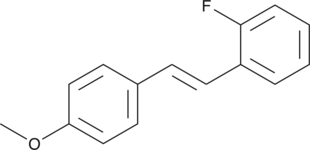Description
An iridoid glycoside with diverse biological activities; reduces hydrogen peroxide-induced apoptosis in SH-SY5Y cells from 0.25-12.5 µM; inhibits COX-1 activity (IC50 = 3.55 µM), as well as LPS-induced TNF-α formation (IC50 = 154.6 µM) in RAW 264.7 cells; reduces food intake, blood glucose levels, and serum triglyceride levels, as well as increases serum HDL levels in db/db diabetic mice at 20 and 100 mg/kg; attenuates scopolamine-induced memory deficits in the Morris water maze and passive avoidance test in mice; reduces serum and kidney AGE and MDA levels and improves renal function in a mouse model of diabetic nephropathy at 20 and 1,000 mg/kg
Formal name: 1-(β-D-glucopyranosyloxy)-1S,4aS,5,6S,7R,7aS-hexahydro-6-hydroxy-7-methyl-cyclopenta[c]pyran-4-carboxylic acid, methyl ester
Synonyms: 7-hydroxy-6-desoxy Verbenalin|NSC 606403
Molecular weight: 390.4
CAS: 18524-94-2
Purity: ≥98%
Formulation: A crystalline solid
Product Type|Biochemicals|Natural Products|Glycosides||Product Type|Biochemicals|Ox Stress Reagents|Antioxidants||Product Type|Biochemicals|Small Molecule Inhibitors|Cyclooxygenases||Research Area|Cardiovascular System|Kidney & Renal Disease|Diabetic Nephropathy||Research Area|Cardiovascular System|Lipids & Lipoproteins|Lipoproteins||Research Area|Cell Biology|Cell Death|Apoptosis||Research Area|Endocrinology & Metabolism|Metabolic Diseases|Diabetes||Research Area|Endocrinology & Metabolism|Metabolic Diseases|Dyslipidemias||Research Area|Immunology & Inflammation|Innate Immunity||Research Area|Lipid Biochemistry|Cyclooxygenase Pathway||Research Area|Neuroscience|Behavioral Neuroscience|Learning & Memory||Research Area|Oxidative Stress & Reactive Species|Antioxidant Activity||Research Area|Oxidative Stress & Reactive Species|Carbohydrate Oxidation||Research Area|Oxidative Stress & Reactive Species|Lipid Peroxidation




